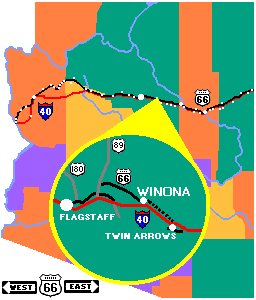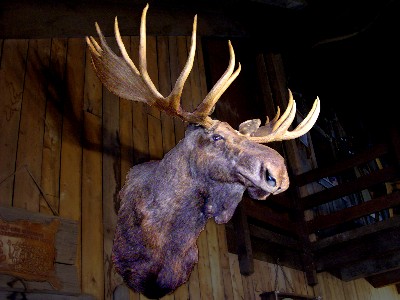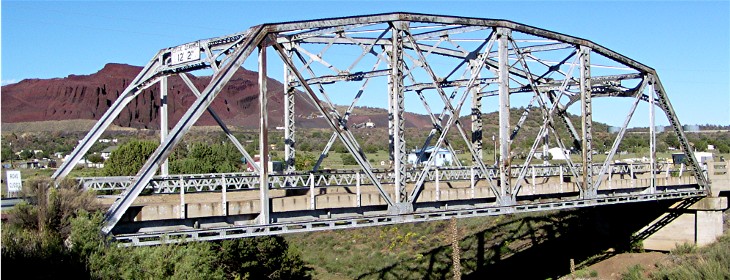 |
| Clickable Map. Winona. |
Don't forget Winona--or elk on the road. It is not likely
that the Arizona State Department of Highways will forget Winona. In
December 1998, Jerry Booth was severely injured when his car collided with
an elk on Interstate 40 near the Winona exit (milepost 211).
Mr. Booth sued the state claiming that Arizona had failed to exercise
reasonable care in light of the known elk hazard and had not used
appropriate fencing, cleared vegetation to improve visibility or reduced
the speed limit. The jury found in favor of Mr. Booth, and the state
appealed.
On appeal, Arizona contended that the state should not be held
responsible for elk wandering across the interstate. The Court of
Appeals reviewed the facts of the case. They found that elk, which
weigh between 550 and 850 pounds, have had an increasing population in
northern Arizona since 1980. They also found that although Arizona
had placed signs in the area warning of the elk hazard, it is unlikely
that an attentive driver traveling at the posted 75 mph speed limit would
be able to avoid a collision with a fast moving elk should it dart onto
the highway.
 |
| One doesn't have to chance elk sightings on Route 66
or Interstate 40. A view of the large critters is assured if one
takes a slight detour to visit Deer Farm.
The moose pictured is more stationary than those at the deer farm,
having been mounted on the wall of the Mormon Lake Lodge, just south
of Flagstaff. 6-04. |
The court also found that the fencing along Interstate 40 is not
designed to and does not prevent elk from entering the roadway. In
the particular five mile section of I-40 where Mr. Booth collided with the
elk, there were 168 reported collisions with elk between 1994 and 2000.
At trial an expert testified that in nine other states and in Canada,
eight foot fences and underpasses for the elk were used to prevent elk
from entering roadways. He also testified that had those precautions
been used on I-40, the collision rate would have been reduced by 96%.
The state lost its appeal, and Mr. Booth kept his judgment.
|
Even-toed Herbivore Primer
A moose is an elk is a deer. Moose and elk are
large, even-toed herbivorous mammals of the deer family.
Their scientific name is Alces alces (Kingdom: Animalia;
Phylum: Chordata; Subphylum: Vertabrata; Class: Mammalia;
Subclass: Theria; Order: Artiodactyla; Family: Cervidae;
Subfamily: Odocoilinae; Genus: Alces; Species: alces).
Moose-smoose. An adult male moose weighs from 1200
to 1500 pounds and stands 6½ to 7½ feet at the shoulders, making
them the largest members of the deer family. They live 15 to
25 years, barring unfortunate incidents with motorists along I-40
or hunters around Mormon Lake. They are generally bigger in
Alaska (an Alaskan Moose discovered in 1897 holds the record
standing at 7.68 feet and weighing just under 1,800 pounds) and
smaller as one heads south. The Shiras moose, also known as
the "Wyoming" or "Yellowstone" moose, is the
smallest of the moose family. Adults of this variety weigh
in at 600 to 1400 pounds. For comparison, the adult domestic
horse will weigh from 1,300 to 2,000 pounds, and stand 5 to 7 feet
in height at the shoulders.
Elk are mini-moose. Elk are smaller and more
social. In summer Elk may be found in herds of up to 400
animals, lead by a single cow. The Rocky Mountain Elk, which
have a range along the Rocky Mountains from British Columbia south
to New Mexico, weigh from 500 to 700 pounds as adults. The
Rocky Mountain Elk have take up residence in Arizona where they
are said to offer some of the best elk hunting in the world.
European moose. In Europe, elk are called moose,
while moose aren't called anything since there are none.
This nomenclature confuses only those familiar with the North
American deer family where there really are moose and elk.
Non-herbivorous moose & elk. Alces alces
has inspired more fraternal organizations than any other species.
The Benevolent & Protective Order of Elks was founded in 1868,
with no apparent intention to be benevolent or protective of elk.
Precisely two decades later (1888), the Loyal Order of Moose came
into being. Other species do have their fraternal societies
[Haliaeetus leucocephalus--Fraternal Order of Eagles
(1898); Panthera leo--Lions International (1917);Homo
sapiens--Independent Order of Odd Fellows (1819)], but only
this branch of the deer family has two such organizations.
Collective moose. Moose, elk and deer are
collective nouns. One moose is a moose, but two or more
moose are still just moose. BPOE notwithstanding, there are
no elks, mooses, or deers.
|
|
|
